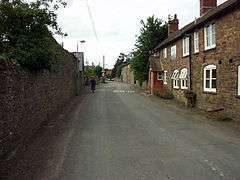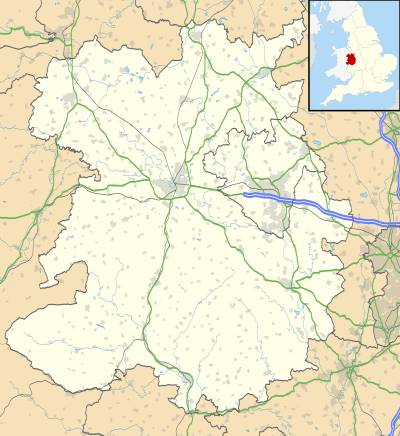Wistanstow
Wistanstow is a village and parish in Shropshire, England. Wistanstow is located about 5 miles (8.0 km) south of Church Stretton and 8 1⁄2 miles (13.7 km) north of Ludlow. It is about 2 miles (3.2 km) north of Craven Arms. It is just off the main Shrewsbury-Hereford road, the A49. The large parish, of 5,231 acres (8.2 sq mi; 2,100 ha),[1] includes a number of other small settlements: Woolston, Upper Affcot, Cwm Head, Bushmoor, Strefford, Whittingslow, Felhampton and Cheney Longville, and a population of 724 was recorded in the 2001 census,[2] increasing to 812 at the 2011 Census.[3]
| Wistanstow | |
|---|---|
 Main street through Wistanstow village | |
 Wistanstow Location within Shropshire | |
| Area | 8.17 sq mi (21.2 km2) |
| Population | 812 (2011) |
| • Density | 99/sq mi (38/km2) |
| OS grid reference | SO434857 |
| Civil parish |
|
| Unitary authority | |
| Ceremonial county | |
| Region | |
| Country | England |
| Sovereign state | United Kingdom |
| Post town | CRAVEN ARMS |
| Postcode district | SY7 |
| Dialling code | 01588 |
| Police | West Mercia |
| Fire | Shropshire |
| Ambulance | West Midlands |
| UK Parliament | |
The River Onny flows through the parish, southwest of the village, also Leamoor Common and Wettles are to the north of the village.
History and amenities
The main lane running through the village is a Roman road, which ran between the Roman settlements and forts at Leintwardine and Wroxeter.[1]
The village takes its name from the Anglo-Saxon saint Wigstan who was the grandson of the King of Mercia. He was martyred at this location by his great‑uncle.[lower-alpha 1] His burial took place at his family crypt at the abbey of Rependon (now known as Repton) the Mercian capital, memorialized as St. Wystan upon his canonization (one of the oldest unaltered places of Christian worship in England). The Saxon suffix stow means (enclosed) place. An uncle of W(ystan) H(ugh) Auden (named for the eponymous saint spelled Wystan by his father who was an alumnus of Repton school built on the remains of the Abbey) wrote the entry for Wistanstow in Little Guide to Shropshire[6][lower-alpha 2]
The present church building, Holy Trinity, was mainly built between 1180 and 1200. The nave roof of 1630 is one the church's finest features and was re-gilded in the mid-1960s. The interior is also graced by a number of early 19th century box pews and fine mid-20th-century wooden panelling behind the altar. It contains a war memorial plaque to local men who died serving in the World Wars and another to Lieutenant Colonel Henry Beddoes who was lost when S.S. Chiosa hit a wartime mine off Sicily in January 1919.[9]
Wistanstow has a splendid mock Tudor village hall that was given to the village in 1925 by a local landowner. This enormous "black‑and‑white" building included cottages for the district nurse and resident caretaker. The village has a small church primary school.
At the other end of the village opposite Manor Farm is the Plough Inn. Just behind is a small independent real ale brewery, "Wood's". In 1984, both the Plough and the brewery were featured as the final destination on a Shropshire edition of Treasure Hunt, with Anneka Rice pulling herself a pint of real ale to complete the game. “The Smithy” is the village’s community shop which was officially opened by the actor Pete Postlethwaite OBE, a local parishioner in April 2000. Once the workplace of a local blacksmith and little more than the size of a shed, the shop stocks all the basics, with as much as possible sourced from local suppliers.
See also
Notes
References
- "UK Genealogy Archives Wistanstow Shropshire". Retrieved 28 July 2018.
- National Statistics South Shropshire parishes
- "Civil Parish population 2011". Retrieved 28 November 2015.
- Rev. Alban Butler 1711–73. "June 1 – St. Wistan, Prince of Mercia, Martyr". The Lives of the Saints. Retrieved 21 March 2013.
- Alban Butler (1711–1773) (1997). Kathleen Jones (ed.). The Lives of the Saints. Volume VI: June. The Liturgical Press. ISBN 978-0814623824.
The Lives of the Fathers, Martyrs, and Other Principal Saints. Compiled from Original Monuments and Authentic Records by the Rev. Alban Butler, in Twelve Volumes. PUBLISHED: Dublin: James Duffy, 1866
- John Ernest Auden (1932). Shropshire. The little guides. Methuen. ASIN B00085YFOO.
- Jonathan Calder (5 March 2007). "The martyrdom of St Wystan". Liberal England. Retrieved 21 March 2013.
- Humphrey Carpenter (1981). W. H. Auden: A Biography. Houghton Mifflin. ASIN B000I823HW. ISBN 978-0395324394.
- Francis, Peter (2013). Shropshire War Memorials, Sites of Remembrance. YouCaxton Publications. p. 97. ISBN 978-1-909644-11-3.